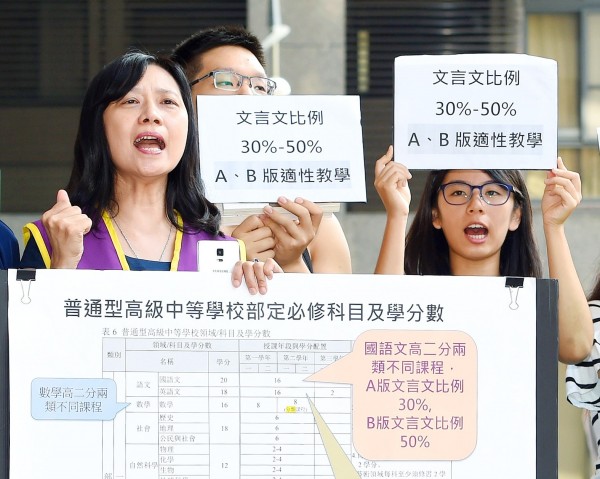《TAIPEI TIMES》 Original curricula proposal upheld

Education groups hold a news conference outside the Ministry of Education yesterday, while a committee on the ratio of modern Chinese to classical Chinese in the high-school curriculum meets inside. Photo: Liao Chen-huei, Taipei Time
STUDENTS’ CHOICE: Groups protesting outside the meeting called for two curricula, one that would focus on classical Chinese and another that is English-heavy
By Rachel Lin and William Hetherington / Staff reporter, with staff writer
A proposal by the curriculum review committee to reduce the proportion of classical Chinese content in high-school Chinese-language curricula to between 45 and 55 percent is to be upheld, Ministry of Education K-12 Education Administration Division head Chiu Chien-kuo (邱乾國) said yesterday.
A subcommittee had proposed a reduction to about 30 percent, but a meeting on the curriculum issue held by the ministry yesterday voted to maintain the original proposal by the committee, which is overseen by the National Academy for Educational Research.
Several other proposals were brought up during the meeting, including the complete elimination of classical Chinese from the curriculum guidelines to hand the decision to teachers, keeping the percentage at 40 to 50 percent, keeping it at 30 to 40 percent, and setting it at 30 percent, Chiu said.
As no consensus could be reached, the meeting opted to go back to the original proposal of 45 to 55 percent, Chiu added.
The proposed change, which is expected to take effect in 2019, has elicited heated reactions from educators and the public, with many disagreeing about the importance of classical Chinese in modern Taiwanese education.
Yesterday’s meeting was attended by 45 of the 48 committee members who discussed eight curriculum changes. The classical Chinese issue was the seventh and most highly contentious of the issues discussed.
Outside the venue, student representative Hsiao Chu-chun (蕭竹均) spoke on behalf of student groups in Kaohsiung, Hsinchu and Changhua who are not content with the curricula.
The groups said that rote memorization of classical poetry — which accounts for 75 percent of high-school Chinese-language classwork and 90 percent of the literature portion of high-school entrance exams — fails to help students understand the significance of the poems while excluding other forms of literature.
Students said they are pressured to read modern texts on their own, given the pace of the classes and the focus on classical literature.
They supported a reduction to about 30 percent and called on the ministry to introduce more Taiwanese literature into the curriculum.
Meanwhile, members of groups including the National Education Action Alliance, the Taiwan Association for the Development of Adaptive Education, the Nationwide Twelve-Year National Education Parents’ Alliance and the Taiwan Early Childhood Education Association also protested outside the meeting venue, calling for implementation of split curricula allowing students to choose either an English-heavy or a classical Chinese-heavy course load.
The classical Chinese path would maintain current curricula while the English stream would reduce the ratio of classical Chinese texts to 30 percent, they said.
新聞來源:TAIPEI TIMES















